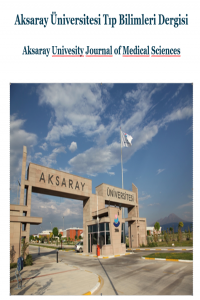Dijital çağın yeni salgın hastalığı: Bilgisayarlar gözümüze düşman mı?
Miyopi, Refraksiyon, korneal topografi, bilgisayar göz sendromu, korneal biomekanik
The new epidemic disease of the digital age: Are the computers enemy to our eyes?
___
- Jaiswal S, Asper L, Long J, Lee A, Harrison K. Ocular and visual discomfort associated with smartphones, tablets and computers: what we do and do not know. Clinical and Experimental Optometry, 2019 102(5), 463-477.
- Coles-Brennan C, Sulley A, Young G. Management of digital eye strain. Clin Exp Optom 2019;102:18-29.
- Mocci F, Serra A, Corrias GA. Psychological factors and visual fatigue in working with video display terminals. Occup Environ Med 2001;58:267-71.
- Salibello C, Nilsen E Is there a typical VDT patient? A demographic analysis. J Am Optom Assoc 1995;66: 479-83.
- Blehm C, Vishnu S, Khattak A, Mitra S, Yee RW. Computer vision syndrome: a review. Surv Ophthalmol 2005;50(3):253-62.
- Rosenfield M. Computer vision syndrome: a review of ocular causes and potential treatments. Ophthalmic Physiol Opt 2011;31(5):502-15.
- Sheppard AL, Wolffsohn JS. Digital eye strain: prevalence, measurement and amelioration. BMJ Open Ophthalmology, 2018; 3(1).
- Reddy SC, Low CK, Lim YP, Low LL, Mardina F, Nursaleha MP. Computer vision syndrome: a study of knowledge and practices in university students. Nepal J Ophthalmol 2013; 5: 161–168.
- Logaraj M, Madhupriya V, Hegde S. Computer vision syndrome and associated factors among medical and engineering students in Chennai. Ann Med Health Sci Res 2014; 4: 179–185.
- Wen L, Cao Y, Cheng Q, Li X, Pan L, Li L, et al. Objectively measured near work, outdoor exposure and myopia in children. British Journal of Ophthalmology. 2020 Feb 19.
- Hanne W, Brewitt H, Augenklink Rechts DI, Munchen TU. Changes in visual function caused by work at a data display terminal. Ophthalmologe 1994;901: 107-12.
- Akkaya S, Atakan T, Açıkalın B, Aksoy S, Özkurt Y. The Effect of Long Term Computure Use on Dry eye. Northern Clinics of İstanbul. 2018; 5(4) 319-322
- Munshi S, Varghese A, Dhar-Munshi S. Computer vision syndrome-A common cause of unexplained visual symptoms in the modern era. Int J Clin Pract. 2017;71(7).
- Ranasinghe P, Wathurapatha WS, Perera YS, Lamabadusuriya DA, Kulatunga S, Jayawardana N, et al. Computer vision syndrome among computer office workers in a developing country: an evaluation of prevalence and risk factors. BMC Res Notes. 2016;9:150.
- Hirota M, Uozato H, Kawamorita T, Shibata Y, Yamamoto S. Effect of incomplete blinking on tear film stability. Optom Vis Sci. 2013;90:650
- Gowrisankaran S, Sheedy JE. Computer vision syndrome: a review. Work 2015; 52: 303– 314.
- Nakamura S, Kinoshita S, Yokoi N, Ogawa Y, Shibuya M, Nakashima H et al. Lacrimal hypofunction as a new mechanism of dry eye in visual display terminal users. PLoS One 2010; 5(6):e11119.
- Pararajasegaram R. VISION 2020-the right to sight: From strategies to action. Am J Ophthalmol 1999;128:359–360.
- Vitale S, Sperduto RD, Ferris FL III. Increased prevalence of myopia in the United States between 1971-1972 and 1999-2004. Arch Ophthalmol 2009;127:1632–1639.
- Lin LL, Shih YF, Hsiao CK, Chen CJ. Prevalence of myopia in Taiwanese schoolchildren: 1983 to 2000. Ann Acad Med Singapore 2004;33:27–33.
- Dong L, Kang YK, Li Y, Wei WB, Jonas JB. Prevalence and time trends of myopia in children and adolescents in china: a systemic review and meta-analysis. Retina. 2020 Mar 1;40(3):399-411.
- Fernández-Montero A, Olmo-Jimenez JM, Olmo N, Bes-Rastrollo M, Moreno-Galarraga L, Moreno-Montañés J, et al. The impact of computer use in myopia progression: a cohort study in Spain. Preventive medicine, 2015 71, 67-71.
- Muhamedagic L, Muhamedagic B, Halilovic EA, Halimic JA, Stankovic A, et al. Relation between near work and myopia progression in student population. Materia socio-medica, 2014 26(2), 100-3.
- Niroula DR, Saha CG. Study on the refractive errors of school going children of Pokhara city in Nepal. Kathmandu Univ Med J (KUMJ) 2009;7:67–72.
- Lingham G, Mackey DA, Lucas R, et al. How does spending time outdoors protect against myopia? A review. British Journal of Ophthalmology, 2020 104(5), 593-599.
- Williams KM, Bertelsen G, Cumberland P, Wolfram C, Verhoeven VJ , Anastasopoulos E et al. Increasing Prevalence of Myopia in Europe and the Impact of Education. Ophthalmology. 2015 Jul;122(7):1489-97.
- Huang HM, Chang DS, Wu PC. The Association between Near Work Activities and Myopia in Children-A Systematic Review and Meta-Analysis. PLoS One. 2015 Oct 20;10(10):e0140419.
- Kinge B, Midelfart A, Jacobsen G, Rystad J. The infuluence of near-work on development of myopia among university students. A three-year longitudinal study among engineering students in Norway. Acta Ophthalmol Scand.2000 Feb;78(1):26-9
- Lin Z, Vasudevan B, Jhanji V, Mao GY, Gao TY, Wang FH et al. Optom Vis Sci. Near work, outdoor activity, and their association with refractive error. 2014 Apr;91(4):376-82.
- Motlagh M, Geetha R. Physiology, Accommodation. (2020) StatPearls [Internet].
- ISSN: 2757-6655
- Yayın Aralığı: Yılda 3 Sayı
- Başlangıç: 2020
- Yayıncı: Aksaray Üniversitesi
Berfin OKTAY, Ayşe GÖKÇE, Ali ÖZER
TEDAVİ ALAN ERKEK EROİN BAĞIMLILARINDA SOSYODEMOGRAFİK VE KLİNİK ÖZELLİKLER
Medine GIYNAŞ AYHAN, Emine YILDIZGÖREN
Acil Serviste Yapay Zeka Kullanımı
Zamir Kemal ERTÜRK, Bahadır ERTÜRK
Acil Servise Hasta Müracaatı Çalışan Doktorlara Göre Değişiyor Mu? : Özgün Bir Çalışma
Taner ŞAHİN, Humeyra ASLANER, Zübeyde KORKMAZ, Mükerrem ALTUNTAŞ, Mustafa ERKAN, Murat ÇELİK
Filiz KÜRKLÜ BOZKIR, İlhami ÇELİK, Seval SÖNMEZ YILDIRIM
Senkopta Nadir Tanı: Tip 2 Brugada Sendromu / A Rare Diagnosis of Syncope: Type 2 Brugada Syndrome
Sertaç GÜLER, Dilber ÜÇÖZ KOCAŞABAN
Pandemide Maskelenen Tanı: Nüks Sıtma Olgusu
Mustafa YILMAZ, Sevil ALKAN ÇEVİKER, Aynur GÜLCAN, Emine Kübra DİNDAR DEMİRAY
Hatice ÖNTÜRK, Sevil ALKAN ÇEVİKER, Emine Kübra DİNDAR DEMİRAY
COVID 19 Döneminde Karantina Uygulamalarının Sağlık Okuryazarlığı Bakış Açısıyla Değerlendirmesi
Emine Kübra DİNDAR DEMİRAY, Sevil ALKAN, Hatice ÖNTÜRK, Mehmet DURGUN
Dijital çağın yeni salgın hastalığı: Bilgisayarlar gözümüze düşman mı?
